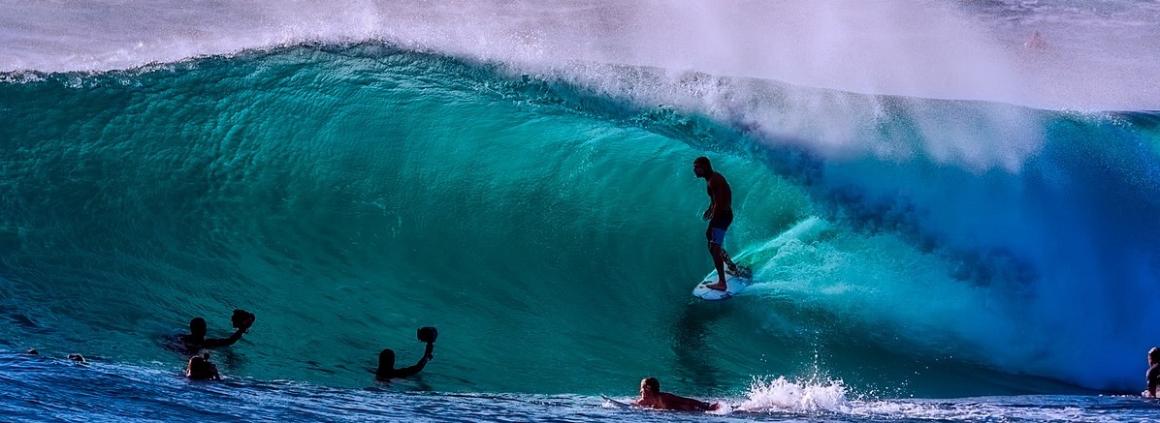
The Physics of Surfing
Phil Kesten
Santa Cruz, California. Oahu, Hawaii. The Gold Coast near Brisbane, Australia. Huge waves–the kind that are routinely 25 or 30 feet high–crash along the shore. And on almost any day when the weather is good, thousands of surfers escape to the beaches to experience a thrilling, high-speed ride driven by the powerful tide.
Like so many areas of life, the art and sport of surfing takes practice–and some basic knowledge of physics doesn’t hurt, either. We tapped Santa Clara University Associate Professor of Physics Phil Kesten to explain the science of surfing, while Rob Covich, Program Associate in Undergraduate Studies–and an experienced surfer–provided useful insights.
You suggest we start our discussion not with the ocean, but with a pond, a rock, and a stick.
If you throw a rock into a pond, it creates ripples that move across the water’s surface, and the energy of that wave disturbs the water. Each small region of water moves up and down as the wave passes. Up and down, but not horizontally. Yes, the location of the disturbance moves horizontally, but not the water molecules themselves. As a wave ripples across the water, a floating stick goes up, then down, then back up to its original position. The stick does not, however, move closer to the shore.
But we’re talking about surfing, and you can’t surf on ripples on a pond.
Correct! That’s because the waves near an ocean coast are different from the waves on a pond. And one significant difference turns ripples into waves that you can surf.
Far from shore, waves take the form of swells. These are regions in which molecules of water are just moving up and down. But the peaks and troughs along the surface of the water also move closer to the shore, pushed along by winds far out in the ocean. And as the swells approach the shore, they encounter shallower and shallower water. Some curious phenomena arise as a result.
Uh-oh...this sounds like a math problem.
All waves obey two simple physical laws. First, as a wave moves from one region to another, the rate at which the wiggles occur—the wave frequency—must remain the same. And second, the product of the frequency and the distance it takes for one complete wiggle—the wavelength—always equals the wave velocity, or speed.
Waves move more slowly in shallower water. For the frequency of a wave to remain the same as it moves to shallower water, the second rule requires that the wavelength of the waves must also get smaller. So as a wave disturbance moves into shallower water, the crests of the waves must therefore get closer together. But the amount of water in each swell can’t change, so as the swells bunch up they must get taller. And when a swell gets tall enough, it ends up falling forward on itself. In surfing lingo, the wave “breaks.”
So, as a wave breaks, anything floating on the surface of the water will fall forward, too, and be carried along into the shore.
Exactly. If you can plant yourself near the top of that swell, just a bit in front of the break…off you go! You’re surfing.
There are some complicated hydrodynamics going on as a surfer, the surfboard, and a breaking wave all come together for that wild ride. The tilt that the surfer gives to the board, both forwards or backwards and from side to side, significantly affect the motion. Channels and curves along the bottom of the board play a role, too. But fundamentally, it is the physics of gravity that makes it all happen.
When you’ve picked your wave, you swing around to face the shore, and paddle quickly to try to match the wave speed. If you can get yourself just ahead of a crest, you are both high up above the average height of the water and also facing downhill!
Gravity pulls you down. You fall.
OK—now you’re surfing. How do you get a long ride?
You need to keep “falling.” The trick, as you know if you’ve ever surfed or just watched people surfing, is to move sideways across the face of the crest, allowing it to pass under you. If you can let the crest pass under you enough so that you are, once again, at the top of it, you can once again fall along the downward slope of the front of the crest. Moving up and down along the face of a wave is the key to surfing. And as the tops of the waves fall forward, the water in each crest begins to follow a circular path, a rolling motion. That’s what gives those monster waves their iconic shape.
What else makes waves so massive, say, at Mavericks near Half Moon Bay?
Waves get bigger—much bigger—when they get funneled into a narrower region as they approach the shore; when the depth of the water goes from deep to shallow at just the right rate; and when there is a longer stretch of water over which the wind can blow to make the waves pick up energy. All of these factors come together in an optimal way to produce big waves in places like Mavericks, or, say, the Banzai Pipeline on the North Shore of Oahu.
How do the size and weight of the surfboard factor in?
An enormous amount of physics goes into surfboard design! Much of it is subtle, but there are a few generalities. First, longer boards tend to paddle faster and be more stable, while shorter boards tend to be more maneuverable. Heavier boards tend to be slower to respond to attempts to change direction, and require more force to do so. And a heavier board makes it easier to fight an off-shore wind as you ride a wave. If you’ve got the wind at your back, though, a lighter board tends to be more responsive.

